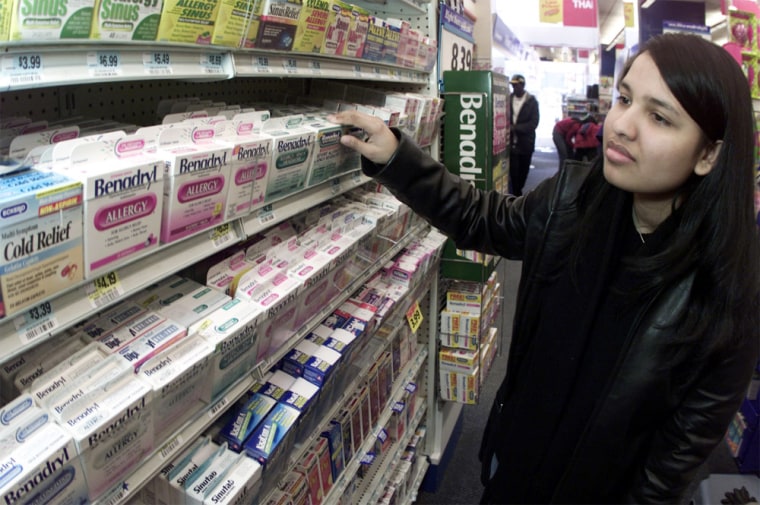Spring is the season of renewal, and for many people that means once again greeting a stuffy nose, sneezing and itchy, watery eyes.
As plants begin to bloom and their pollen is dispersed by the wind, the familiar symptoms of hay fever blossom as well. In the spring, tree pollen is the usual trigger of symptoms, though outdoor mold spores can also cause respiratory woes.
Like all allergies, hay fever arises from an abnormal immune response to a normally benign substance. The immune system produces immunoglobulin E (IgE) antibodies that essentially arm the body to attack the foreign invader -- usually inhaled tree pollen in the case of springtime hay fever.
During this reaction, immune cells release a number of potent chemicals, including histamine, that lead to hay fever misery.
Researchers’ understanding of this immune response forms the basis of many of the treatments available for seasonal nasal allergies, including oral and nasal antihistamines and anti-inflammatory medications.
Pinpointing the trigger
The first step in managing allergies is to get a skin test to confirm that the problem is indeed an allergy and to pinpoint the specific trigger or triggers, says Dr. Christopher Bates of the National Jewish Research and Medical Center in Denver.
Once the culprit is exposed, the allergy sufferer can then avoid it when possible -- though with a pollen allergy, that can prove difficult.
Avoidance is especially tough for people who work or play outdoors, notes Dr. Jonathan Bernstein, an allergy specialist at the University of Cincinnati College of Medicine.
Still, closing windows and running an air conditioner instead can help, according to Bernstein. Other tactics include avoiding outdoor activities when pollen counts are high; not putting clothes on an outside line to dry; and showering after being outside to wash away any pollen that has latched on.
Finding the proper combination
The art of pollen avoidance is not the only option, however.
Several types of oral and nasal medications are known to control hay fever. Devising the right combination depends on the severity of patients’ symptoms and whether they suffer any medication side effects, Bernstein says.
Antihistamines, which block the action of symptom-spurring histamine, are a mainstay of hay fever therapy.
One of the drugs’ drawbacks is drowsiness, but Bernstein points out that newer prescription and over-the-counter antihistamines -- such as fexofenadine (Allegra) and loratadine (Claritin) -- are made to be non-sedating. Other potential side effects include dry mouth, constipation and, in some children, irritability and restlessness.
Oral antihistamines can quash sneezing, itching and eye symptoms, but offer little relief from congestion, so some products have an added decongestant. Decongestants work by acting on blood vessels, and possible side effects include increased blood pressure and sleeplessness.
Inhaled steroids
Prescription nasal corticosteroids, which include medications such as budesonide (Rhinocort) and fluticasone (Flonase), are another cornerstone of treatment. Corticosteroid drugs are similar to a hormone, cortisol, that the body produces naturally. Nasal corticosteroids ease a range of hay fever woes by blocking the release of inflammatory chemicals in the nasal passages. They are intended to be taken daily to prevent symptoms, starting shortly before the onset of pollen season.
Inhaled steroids can cause nasal irritation, including nose bleeds, and there have been concerns over their possible effects on children’s growth. But, Bernstein says, studies show the drugs are safe when used appropriately for allergies and asthma.
Nasal-spray decongestants offer a temporary reprieve from a stuffy nose, but should not be used for more than a few days because they can actually make congestion worse if used longer.
Bates says an "often overlooked" part of hay fever treatment is the nasal wash, a salt-water solution that can help remove mucus and pollen from the nose -- and clear a path for inhaled medications to do their job.
For hay fever that is particularly severe or that persists beyond spring due to sensitivity to several allergens, allergy shots may be an option. This treatment, also called immunotherapy, involves injecting small amounts of the offending substance, over time, in order to normalize the immune response.
Immunotherapy can quell hay fever, and may even prevent seasonal allergies from progressing to asthma, Bernstein says. But for most people with only springtime hay fever, other tactics should do the trick.
Bernstein stresses that with preventive medications like inhaled steroids, consistency is key.
"These work best when used on a regular basis to prevent symptoms from occurring," he says.
Alternative treatments
Some alternative treatments are marketed for allergies, but they have not been well-studied.
Bates points to one study showing that grape seed extract -- suggested to have antihistamine effects -- was no better than a placebo in easing seasonal allergies.
Another botanical called butterbur was shown in one recent study to be as good as a prescription antihistamine in improving quality of life among people with hay fever. But the long-term safety of the product is unclear; the butterbur plant itself contains toxic alkaloids that can damage the liver.
According to Bernstein, many allergy patients come see him after they’ve failed to find relief from herbal remedies.
"With a lot of these things," he says, "the claims are not well-substantiated."
